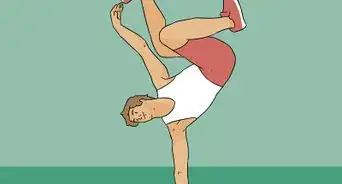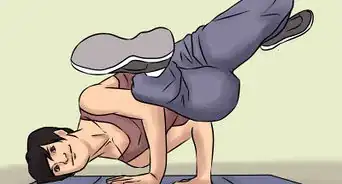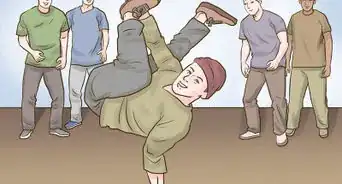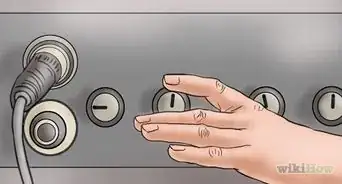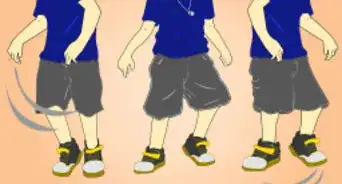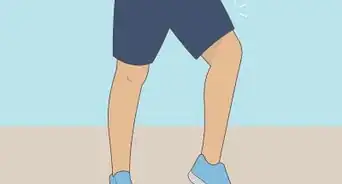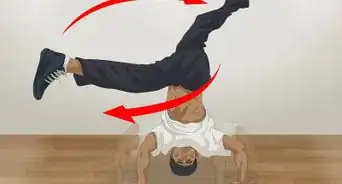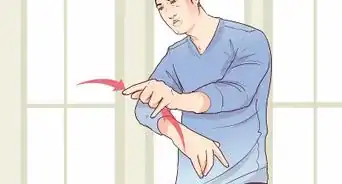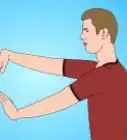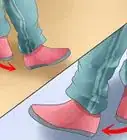wikiHow is a “wiki,” similar to Wikipedia, which means that many of our articles are co-written by multiple authors. To create this article, 34 people, some anonymous, worked to edit and improve it over time.
The wikiHow Video Team also followed the article's instructions and verified that they work.
This article has been viewed 187,201 times.
Learn more...
The windmill is a popular b-boying move that takes practice, discipline, and most of all, dedication. To do a windmill, you have to roll your torso continuously in a circular path on the floor, using your arms and chest for support, while you twirl your legs in the air in an extended V-shape. The trick to pulling it off is using the strength of your arms while generating power and momentum from your legs.
Steps
Getting the Basics Down
-
1Crouch on the ground on your knees. Before you do the windmill, you have to get down on the floor. This can help you position your hands correctly, so you can support yourself as your legs start spinning. As you get ready to place your hands down, your head can be out in front of you, just a few inches from the ground.[1]
-
2Get into a hang-glide position. You should already be comfortable and familiar with this position if you want to be able to do the windmill. To do this right, you just have to place your left elbow between your waist and rib cage, and your right hand diagonally up and to the right of your left hand. The fingers of your right hand should be pointing straight away from you, while the fingers of your left hand should be pointing to your left side, so they make a right angle with your right fingers.[2]
- The hang-glide is a version of a freeze, which is a technique that involves halting body motion, in order to make it look like you're literally "freezing" in the air. This is similar to the turtle freeze, except in the turtle freeze, both elbows are stabbed into your gut instead of just one.
- Some people also call this move the "crab freeze."
Advertisement -
3Push the ground with your right hand while lifting your legs with bent knees. This will get you in the position you need to be in to start swinging your legs around. You should already have the strength to lift up your legs a bit, as if you're going to go into the handstand position. Now, your legs will be ready to spin around counter-clockwise.[3]
- You can also do this move in reverse, placing your right elbow into your gut and your left hand out, in order to move clockwise.
-
4Swing your left leg around counter-clockwise. Now, dig that left elbow into your gut and really push off of that right leg to get your left leg swinging up and counter-clockwise, so it cuts the air at a 45-degree angle as it moves up. This leg will wind up and will generate the power and momentum to get your right leg swinging forward. Your knee should be bent a bit, so it's easier for you to move your leg. If your leg is too straight, you'll have less control.[4]
- As your legs move up higher, your front body and head will move down lower close to the ground, because your weight will be balancing. You'll need to maintain a strong center of gravity to keep your head from falling too close to the ground or from not having enough height to get your legs up.
- Though you should know and master the hang-glide position before you start swinging your legs around, you can actually keep that left elbow away from your gut until you start swinging that leg around. Once you kick that left leg, you can then place the elbow into your gut, so you have more height when you begin the kick. Some people do start in the hang-glide position, so it's up to you to see what works best.
-
5Swing your right leg around in front of the left leg. Now, the power from your left leg should have given your right leg enough power to start swinging forward in front of it. The right leg should dip down a bit as the left leg swings forward, and then it should naturally rise up. This may seem a little confusing because you'd expect the leg in front to move forward first, but you need that back left leg to generate momentum for the right leg.
- Your right leg should also be bent a bit as it swings in front of your left leg.
- Keep in mind that, while they say that your legs are in a "V" shape, in a true windmill, the legs are actually further apart and can even approach more of a straight line than a V-shape, if you get enough momentum going, so they almost look like helicopter blades.
-
6Kick your left leg under your right leg while collapsing. Now, that left leg will actually swing under that right leg, almost like a scissor, as you turn over and begin to collapse. To collapse, roll off your left hand and on to your left forearm. Move to your left shoulder and then to your back.
- To collapse, your left elbow will move out of your gut and your forearm will bend along your tricep. This will help get your hand out of the way as you move onto your back.
-
7Lift your left leg while kicking your right leg under. At the same time, roll onto your right shoulder and get back into the hang-glide position. This may be the trickiest part. Essentially, you have to generate enough momentum to get back to the position you started from, so you can do the windmill again and again. If you don't generate enough momentum, you'll be stuck on your back without enough speed to roll onto your hands again.
- You can work on getting one cycle really down at first a bit more slowly, because to keep repeating the process, you'll have to really generate a lot of speed and momentum, and that can be hard when you're just learning the ropes.
-
8Catch the hang-glide position again. As you roll onto your back, use your left hand to push the floor away from you to make it easier to turn back onto your side, then, as your left arm swings over your side, you'll be pressed onto your right forearm, which you can use to push your body up a bit to get closer to the starting position.
- Then, you'll turn back onto your chest, pushing the floor away with your hands, and will angle your stomach back onto your left elbow with your left hand under it and your right arm out, just as you did the first time.
- Getting in a stable hang-glide position again is crucial to maintaining your momentum and keeping your balance as you repeat the windmill. If you don't have a solid foundation, you won't be able to swing your legs around without getting off-kilter.
-
9Swing your left leg around and repeat the process. Once you've got the basics of the windmill down, then you can start all over again and work on really getting it down. When you're ready to stop, you can practice stopping on your left hand and then twisting at your waist with your legs bent. When you first start out, you may only be able to do one or two windmills in a row, but the more you do it, the more you'll be able to do without losing your momentum or balance.
- You can also transition into another move, like the backspin, if you want.
Mastering the Windmill
-
1Improve your technique. As you get more comfortable with the windmill, you can work on gaining flow, smoothness, and creating a complete motion with the windmill. At first, you may think of it as a move that is done step-by-step, but when you really get it down, you'll start to see it as one smooth motion.
- You can work on practicing your kick and really getting a good whip with that left leg.
-
2Do a power windmill. A power windmill still requires you to move your legs around, but you'll be rotating on your head instead of using your hands. This will be harder, but it will allow you to try different moves with your hands to mix things up. If you're comfortable pivoting on your head and trying the power windmill, then here are some tricks you can add to your repertoire:
- The Genie. In this power windmill, you cross your hands over your chest.
- The Confusion. Here, you'll place your hands over your face.
- The Eggbeater. In this variation, you can place your hands on your thighs.
- The Lotus. For this move, you'll do a windmill with your legs in the lotus position.
-
3Do a halo. Once you feel like your windmill is really up to speed, then you can try to do a halo, which is an even more advanced move. The halo is similar to the windmill because you'll still be using your arms and chest to support you as your legs spin around, but in the halo, your legs will swing much closer to the floor instead of at an angle, or they can go in the opposite direction, moving more and more vertically until it looks like you're doing a headspin.[5]
- You can think of it as a "halo" because your legs will be moving so fast that you'll be doing one unified move.
Community Q&A
-
QuestionCan I learn this move in about a week if I practice a lot?
 IncredibleGuinevereCommunity AnswerUnless you have a lot of upper body strength and you feel comfortable, you won't be able to do this in a week.
IncredibleGuinevereCommunity AnswerUnless you have a lot of upper body strength and you feel comfortable, you won't be able to do this in a week. -
QuestionHow would I do a continuous windmill?
 Community AnswerAs aforementioned, do what you would when you return to the starting position, except instead of stopping (depending on spin direction), use the inertia of your movement to keep going.
Community AnswerAs aforementioned, do what you would when you return to the starting position, except instead of stopping (depending on spin direction), use the inertia of your movement to keep going. -
QuestionCan I do this in two weeks?
 Community AnswerIt depends on how much you train and practice. It is unlikely that you can do it in two weeks, but it is possible if you train hard enough.
Community AnswerIt depends on how much you train and practice. It is unlikely that you can do it in two weeks, but it is possible if you train hard enough.
Warnings
- Wear a shirt that covers your shoulders or a long sleeve shirt you're going to be rubbing against them and you don't want a friction burn.⧼thumbs_response⧽
- Wear shoes and socks; you don't want to hurt your toes or your ankles.⧼thumbs_response⧽
- Rest. Don't over practice or injuries and/or bad form will result.⧼thumbs_response⧽
References
- ↑ https://www.youtube.com/watch?v=swId_MFHywI
- ↑ http://www.breakdancingninja.com/Articles/Learning%20Windmills/How%20To%20Windmill.html
- ↑ http://www.breakdancingninja.com/Articles/Learning%20Windmills/How%20To%20Windmill.html
- ↑ https://www.youtube.com/watch?v=kH5DvQKZW2I
- ↑ https://www.youtube.com/watch?v=jZTZjX7-R0I
- Videos provided by EverydayMotionsCrew
About This Article
To windmill, start by crouching down on your knees and getting into a hang-glide position, where your legs are spread out in the air and your hands are on the ground. Then, bend your knees and lift your legs while pushing the ground with your right hand so you start to turn. Next, swing your left leg counterclockwise and up into the air so it's at a 45-degree angle. Now, swing your right leg around in front of your left leg and kick your left leg under as you start to collapse. Finally, lift your left leg and catch yourself in the starting position. To learn how to get better at doing windmills, scroll down!


